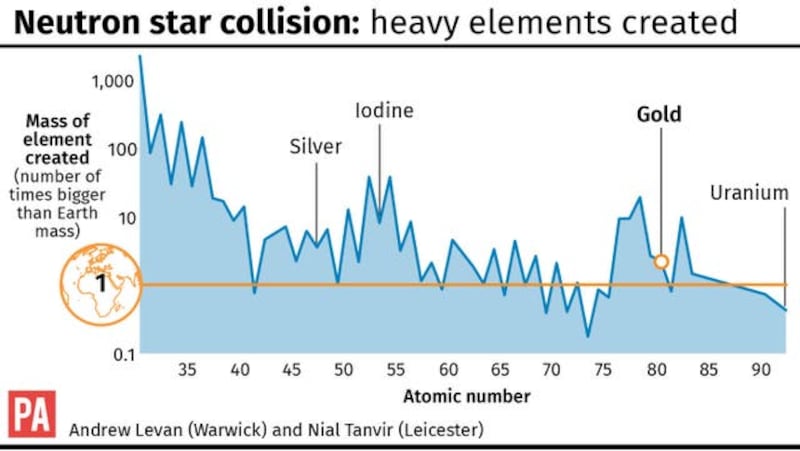Precious metals on earth, such as gold and platinum, may have originated in the stars.
Scientists confirmed this after detecting a titanic collision of two super-dense stars 130 million light years from Earth.
Huge quantities of the precious metal and other heavy elements including platinum and uranium were created in the nuclear furnace lit by the merging neutron stars, confirming theories about their origins and opening a new frontier in astronomy.
The spectacular event also generated ripples in the fabric of the universe, leading to the fifth detection of gravitational waves on Earth – a major discovery in itself.
Here’s everything you need to know:
What is all the excitement about?

Two huge discoveries in one: the first detection of gravitational waves from colliding neutron stars, and the origin of heavy elements including gold, platinum and uranium.
Scientists not only “heard” the phenomenon by measuring vibrations in space-time, they also used satellite and ground-based telescopes to see light and radiation pouring out of the stellar fireball, dubbed a “kilonova”.
What are neutron stars?
They are the super-dense burned out remnants of dead giant stars that have exploded and collapsed.
Their protons and electrons, charged sub-atomic particles, are squeezed together so hard that most of them merge to form inert neutrons.
One teaspoon-full of neutron star material on Earth would weigh a billion tons.
How is the gold made?

It is a kind of alchemy. To make gold, you need to take the nuclei of a lighter “seed” element, such as iron, and give it extra neutrons – inert particles that carry no electric charge, but contribute greatly to the “weight” of an atom.
How this occurs in the universe has been a long-standing mystery.
It could only happen in very violent circumstances – for instance, when a dying giant star explodes as a supernova.
How much gold?
An awful lot. Scientists analysing chemical fingerprints from the radiation produced by the explosion calculated the mass of gold to be greater than the whole of the Earth.
They now believe colliding neutron stars may be the source of half of all the heavy elements in the universe.
What about the gravitational waves?

Gravitational waves are ripples in space-time that were predicted by Albert Einstein 100 years ago.
This was only the fifth time they had ever been detected.
On every previous occasion, the gravitational waves were produced by colliding black holes.
This time the source was completely different – two neutron stars distorting space-time as they spiralled towards each other and collided.
How was the discovery made?

First, the gravitational waves were detected by the Ligo (Later Interferometer Gravitational-Wave Observatory) facility in the US.
Two seconds later, a Nasa satellite picked up a burst of gamma rays from the explosion.
Another gravitational wave detector in Italy helped the scientists pinpoint the source in an ageing galaxy, NGC 4993.
Optical and radio telescopes around the world were quickly pointed towards the flash in a small patch of the southern sky.
The precious metals and other heavy elements were detected in the chemical fingerprints of the radiation.








